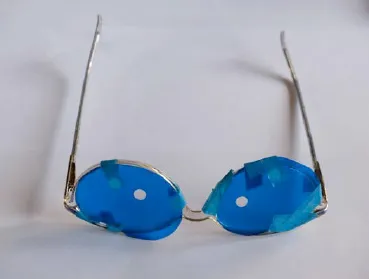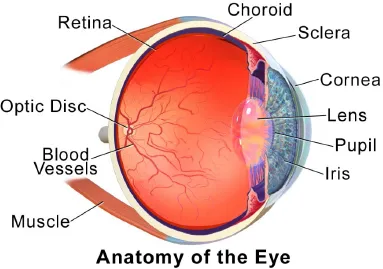![]()
II
Causes and Treatment of
MYOPIA
We live in a sea of light. It is so pleasant and accessible that, most of the time, we are all completely unaware of the light that surrounds us. There are rare occasions when we may notice the quality of light and no longer take it for granted, such as on a sunny day at the beach. But, just as a fish usually does not look outside the water, we hardly ever look beyond our encompassing world of light. When we do, it is generally not the light’s source that captures our attention, but rather the remnants such as tiny glistenings on drops of water, small sparkles on grains of sand, or even just sudden glare from a piece of chrome or glass.
There are three main sources of light that we live under: sunlight, sky light (which can be either cloudy or blue), and artificial light. Each type of light has its own beauty. On cloudy days we tend to be unaware of the hidden light source, and the light is so soft and muted. On sunny days we are only aware of the warmth and brightness of the light. When we look directly into the sunlight it is blinding and uncomfortable, even though the sun is far above us.
When we see a reflection of the sun on the water or off a shiny car, it can also be uncomfortable, so we look away. When we look directly at a reflection of light source, this is what I call looking into the angle of incidence of the light source. In the angle of incidence, we can see either a clear or diffused reflection or picture of the light source on the reflecting surface. The angle of incidence is always there, but in natural light the reflection of the light source is often rendered almost invisible by the surrounding ambient light.
Artificial light, which is a very close light source compared to that of the sun, is wonderful in many ways. Our whole civilization has been built around it. When we say we need light, people don’t think of a window anymore, they think of a light switch. Electric lights are convenient, and without them many office buildings and hospitals would be completely dark. Artificial light also provides a great enhancement for photography and cinematography by providing allowing us to control the light on subjects. It can be used to add drama or clarity and is an easily controlled light source for photography.
Perhaps most importantly, it enables us to see better at night. But for all of its benefits, there are ways in which electric light is causing us harm, particularly in the area of visual acuity.
Sunlight’s rays converge because the sun (the source) is much larger than the earth. That is why we seldom see the shadow of an airplane—the sun’s rays crisscross around the plane. On an overcast day, the convergence of rays is even greater, as the light is more diffuse, and so we seldom see shadows at all. Under the relatively low light of a cloudy sky, the earth can appear almost as bright as the sky itself. Because of this, a dark day has a very uniform look.
On an average day, if you place a glossy magazine on the ground facing the sky, there will be no mirror-like reflection on the pages’ glossy surface, and the print will be plain and clear. The sun’s light does not create a glare that obscures the print, as often happens under electric light. The reflection of light from a smooth surface, such as a magazine page, or anything else smooth and flat, is known as specular reflection. When the sun’s rays converge, it makes specular reflections that are very minute compared to the specular reflection produced under a desk lamp. A close light greatly magnifies specular reflections whereas the sun, as large as it is, minimizes specular reflections. We naturally look away from sunlight’s glare and, while reading outdoors, if there is glare on your page, you can move it around to avoid the glare. Indoors, under electric light, all light is the same. You can’t alter the impact by moving to a different location.
Because of its intensity and brightness, sunlight has a more penetrating quality, which makes for more absorbed light. That light, in turn, radiates from or through surfaces and helps make them appear more matte. One example of this phenomenon is the way light passes through some body parts, such as a person’s ears or the webbing in the hands. You may notice that a person’s ears seem to glow a brilliant red as sunlight passes through them, much like sunlight passing through and illuminating a leaf. Or, if you put your hand with spread fingers against the sun, you will see the red blood in the hands’ webbing. But it’s not a good idea to look directly towards the sun, so it’s probably better to do that experiment with a light bulb; the light bulb would be safer.
Left: Image is facing overhead sky.
Right: Image is facing overhead electric light.
Experiments with Light and Glare
As I became aware of the various effects and qualities of natural vs. artificial light, my natural curiosity meant that I wanted to investigate further, and so I began to conduct informal experiments. One of the first experiments that I did, concerning the impact of glare, was to see if the shine on a page had any effect on my eyesight. When I looked at an area that had that obvious shine, I wanted to see if it was unclear because of the overlaying gloss, or if the shine was impacting my ability to focus. So, in order to investigate, I placed a strand of human hair (because it was fine, but 3-dimensional) near the area with the glare, and I focused on the hair.
Glare Causes of Visual Lag. No one is able to focus on the hair in the real situation.
I quickly realized that I was not able to hold my focus on the hair. It seemed as though my eye was being drawn to focus on something further away; it was almost the same experience as looking at a mirror. When you look at the surface of a mirror, your eye actually focuses at a distance that is twice as far away. But in my experiment, the influence was even stronger than that, because it is possible to hold your focus on a hair placed on a mirror. I created the same experiment with several other people, all of whom had good near vision, and the same thing happened to them: they were unable to maintain focus on the hair.
This experiment led me to believe that perhaps the crystalline lens (the lens within the eye) could work in parallel with a true focus. For example, it could be focusing at 2 feet when it was supposed to be focusing at 4 feet. As it turns out, that was absolutely true, but not in the way I interpreted the phenomena at that time.
While I was conducting these first experiments, I was hopeful that my vision could be realigned, and my sharp vision restored. I noticed that when I focused on a particular point while traveling in the car, my eye seemed to be working to clear its sight. Since it was springtime, I was beginning to play a lot of outdoor basketball as the days grew longer, and that also seemed to help. Testing at the local optometrist showed that my sight was indeed clearing, and my astigmatism had even disappeared during that time. In an effort to build on the value I had observed during car travel and basketball, I made a pair of filters to wear like sunglasses, which I hoped would mimic the motion effect. I reasoned that making the peripheral area brighter would make it more influential, as it was when the eye tracked objects in motion. Unfortunately, the glasses did not work, and my improvement came to a standstill.
Myopia-Reducing Glasses
A big turning point in my personal research came when I heard about experiments by Torsten Wiesel and Elio Raviola, in which they sutured one eye closed at birth on macaque monkeys.1 In these experiments, the eye that had been sutured shut became extremely myopic. I immediately recognized that when the eye was closed, the eyelid acted like a red filter as the light filtered through, and it changed the eye. I knew that the blue light would likely have an opposite effect on the eye, so why not construct a blue filter to try to improve vision? The filter that I had in mind was easy to design, but I experimented for several years with no significant improvement.
While I was working through this process, I was in contact with an optometrist who wanted to try my blue glasses but complained that he had a difficult time reading through them. I had made them translucent (mimicking a closed eyelid), but I decided to revise the glasses in response to his complaint. I made a hole with a paper punch so that the central vision would be clear when reading with the filters on. The results were dramatic! After reading through the revised glasses for 40 minutes, I could see a few lines further on an eye chart. The improvement was temporary, but each day that I used it, my vision improved. I had this improvement recorded at Johns Hopkins, at the Wilmer eye clinic, where I had become friends with an ophthalmologist. In addition to my distance vision, my near vision also improved. Later, the reason for that became clear to me when I had a better understanding of what was happening.
This was a significant discovery: a blue filter attached to a pair of clear glasses or low power lenses cures low-grade myopia. Here is a brief description of the process and a picture of the prototype. A small hole made with paper punch must be aligned with your eyes at reading distance. When you read through that clear spot, it will appear red by simultaneous contrast. This contrast causes your eye to over-focus (become temporarily more myopic). After 30–50 minutes of reading, you will be much less myopic for a short period of time. Repeated sessions will make the myopia go away permanently. When I first did this, I did not understand why the glasses were also making my close vision better. I now believe it was because the over-focusing was causing me to exercise the focus muscles.
The process, and the result, is what the advocates of wearing “plus glasses” have been trying (but failing) to accomplish. Plus glasses alone will not cause myopic defocus; they simply cause your near vision to relax and do not cause near defocus unless they are powerful enough to overcome the plus refraction already caused by myopia. I have given you a description of what I did to reach these results. What follows below is an explanation of the underlying physical and anatomical changes that take place.
To begin, you should understand that to change a myopic eye to one with normal vision requires making the eye a little more myopic while reading. When a person becomes myopic or near-sighted, he or she is under-focusing, so the rays go too far into the back of the eye, and the eye elongates. With the blue filter glasses, a person over-focuses, making him slightly myopic while reading. That action causes the eye shape to move in the opposite direction, through the movement of blood in the choroid—one of the outer layers of the eye. The blood flow causes the choroid to swell in a hyper-optic situation, which stretches the sclera further from the cornea and lengthens the eye. When blood moves in the opposite direction, it diminishes the pressure, and the elastic sclera compresses and shortens the eye. The eye does not exist in a state of homeostasis, which is when an organ attains a certain size and shape and always remains that way.
Image by Blausen.com staff (2014). "Medical gallery of Blausen Medical 2014". Wiki Journal of Medicine 1 (2).
After making what seemed to me like significant progress with my research, I hit a wall. Since I am a portrait painter, many of my portrait subjects are intelligent and educated individuals such as doctors, lawyers, and college presidents. Comparatively speaking, in the sciences, at least, I was uneducated. Schopenhauer, a famous German philosopher, is credited with describing the three stages of truth in this way:
1. It is ridiculed.
2. It is violently opposed.
3. It is accepted as being self-evident!
I had already accepted the truth of light’s impact on eyesight as self-evident. I tried to explain the nature of light and my discoveries regarding myopia to others, but I was not a scientist. I had no scientific training or credentials, so I was ridiculed. It was a frustrating time.
Myopia: Experiments with Chickens
Because I was not having any success engaging others with my discovery, I decided to go back to basics. I would investigate the etiology of myopia and do an experiment that would show that, indeed, glare on a flat surface like a book page could cause myopia. It was at that point that I began my experiments on the effects of glare on glossy surfaces using chickens.
When I was growing up on the farm, we had many chickens. As a little boy I made friends with a few. I had a pet rooster, Leo Leto, who sat on a table while I painted his picture. I still have that painting. As a member of the 4H-club I won eleven prizes; eight were for first prize for my chickens in the county fair.
Because of this childhood experience, I did not mind doing these unfunded experiments with chicks, investigating how glare on a flat page caused myopia. I sprinkled food on the floor so that the chicks would cause them to peer into the glare.
When chicks scan for food, it is a very similar motion to reading.
My first grade Calvert school lesson, homeschool.
I was fortunate enough to be in contact with an eye researcher at the University of Maryland, who taught me how to design and conduct a valid scientific experiment. He was unusual in that he did not reject my ideas or ridicule me. Instead, he thought that because I was an artist, my observational powers might be valuable. His wife was a docent in the National Gallery in Washington, DC, and he had wanted to be an artist when he was young, but his family had talked him out of that for practical reasons. He is well known in the scientific community as an expert in bird vision, and he measured the chicks’ eyes in the initial experiments.
The significance of experiments wi...





